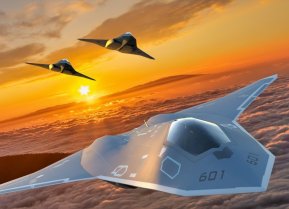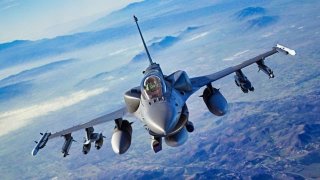The F-16 Looks Truly Like the Unstoppable Fighter Jet
Celebrating its 50th year of service, the F-16 Fighting Falcon remains a cornerstone of global air power, poised to continue its legacy into the mid-21st century.
Summary: Celebrating its 50th year of service, the F-16 Fighting Falcon remains a cornerstone of global air power, poised to continue its legacy into the mid-21st century. Born from the Vietnam War's lessons and the innovative energy-maneuverability theory by Col. John Boyd and Thomas Christie, the F-16 revolutionized air superiority with its agility, cost-efficiency, and advanced capabilities. Winning the Lightweight Fighter Program's competition in 1975, it outperformed rivals with unmatched maneuverability and range, setting the stage for decades of dominance in air combat. The F-16 has seen numerous upgrades over the years, enhancing its weaponry, countermeasures, and radar systems, ensuring its competitive edge over other fourth-generation fighters.
The F-16 Fighting Falcon: Continuing to Soar in the 21st Century
The F-16 Fighting Falcon platform this January officially reached its fifth decade of service. The jet made its debut as an air superiority fighter in the 1970s, and it is expected to continue to serve into the middle of this century.
The F-16 has undergone numerous changes over the years in order to retain an edge over competing fourth-generation fighters. Demand for the plane is still high, as seen by Ukrainian official requests to fly F-16s in their defense against Russia.
The Origin Story of the F-16 Fighting Falcon
The Vietnam War showed U.S. officials their need for a top-flight air superiority fighter and improved air-to-air training for pilots. Around this time, a revered flight instructor, Col. John Boyd, teamed up with a mathematician, Thomas Christie, to develop the energy-maneuverability theory. This concept would become the basis of the Lightweight Fighter Program, or LWF. By the late 1960s, the so-called Fighter Mafia was convened to design a small, lightweight airframe that could function in line with the new theory.
In 1972, General Dynamics and Northrop were awarded contracts worth roughly $39 million each to produce the YF-16 and YF-17 prototypes. Around this time, interest surrounding the new LWF program began to peak in the international community. NATO allies Denmark, the Netherlands, Belgium, and Norway were determined to replace the rapidly aging F-104G Starfighter fighter-bomber. By the middle of the decade, the allies agreed to consider ordering the LWF winner.
The YF-16 prototype was declared the winner of the LWF competition in 1975. The YF-16 was cheaper to operate than comparable aircraft and flew at greater range, and its maneuverability was reportedly lightyears ahead of the other prototypes.
The Navy would go on to select the YF-17 as the basis for what would become the F/A-18 Hornet.
General Configuration and Specs
Each F-16 is powered by a single engine, the Pratt & Whitney F100-PW-229 or General Electric F110-GE-129. Initially, F-16 fighters were equipped with up to six AIM-9 Sidewinder short-range air-to-air missiles, in addition to AIM-7 Sparrow medium-round AAMs. Other air-to-air missiles that can be launched from the F-16 include Maverick, High-Speed Anti-Radiation (HARM), and Shrike missiles. Anti-ship missiles can also be launched, including Boeing Harpoon and Kongsberg Penguin missiles. The airframe launches ordnance from Raytheon-designed LAU-88 launchers and Orgen bomb ejector racks.
The F-16 is strong in countermeasures. Each fighter in this series features the Lockheed Martin AN/ALR-56M radar warning receiver. Additional electronic countermeasures equipment and jammers can be incorporated, including the Raytheon AN/ALQ-184, Northrop Grumman AN/ALQ-131, and others.
Deliveries
In 1978, the first Fighting Falcon variant, the F-16A, was declared operational by the U.S. Air Force. Within a few years, upgraded models were developed with enhancements like the APG-68 radar, Advanced Medium-Range Air-to-Air missiles, and avionics alterations.
Down the line, Block 30/32 variants were introduced, equipped with the HARM missiles and better engines. Block 40/42 Fighting Falcons were the first to feature the terrain-following LANTIRN pod and wide-angle HUD.
Block 50/52 F-16s were designed to replace the F-4G. These variants are equipped with an upgraded version of the AN/APG-68V9 radar that provided a 30% increase in detection range.
Operational History for the F-16
Over its five decades in service, the F-16 has perhaps participated in more combat missions than any of its peers. From Operation Desert Storm and interwar air operations over Iraq, to operations in the Balkans, Israel, Afghanistan and Libya, the Fighting Falcon is a well-tested fighter jet. While the F-16 will gradually be phased out of the Air Force’s arsenal as the F-35 Lightning II takes its place, the legendary platform will always be a favorite among military experts and aviation buffs.
About the Author: Maya Carlin
Maya Carlin, National Security Writer with The National Interest, is an analyst with the Center for Security Policy and a former Anna Sobol Levy Fellow at IDC Herzliya in Israel. She has by-lines in many publications, including The National Interest, Jerusalem Post, and Times of Israel. You can follow her on Twitter: @MayaCarlin. Email the author: [email protected].


